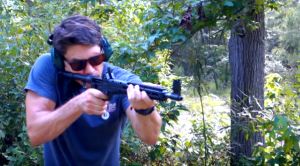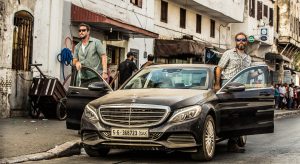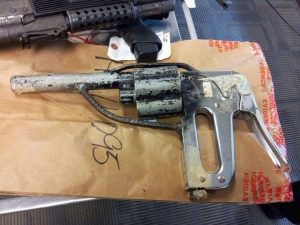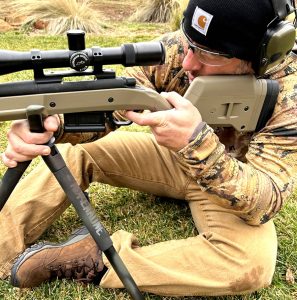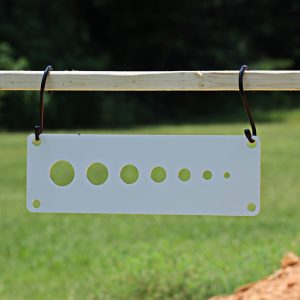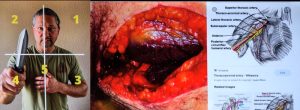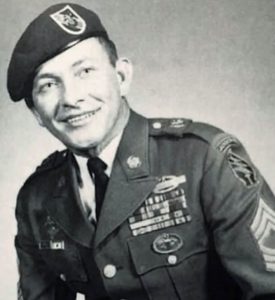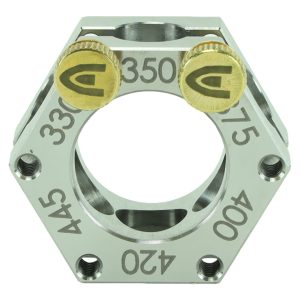This thorough review was done by TFB a while fast forward to the current. Man this Kel-Tec Gen2 Sub2000 9mm has become a big favorite for many peeps out there to throw this into their fun plinking bag. Here’s a quick breakdown for you gun spec nuts:
1. Lightweight Construction: Right off the bat, it’s clear that the Sub2000 is incredibly lightweight, as you’d expect from Kel-Tec. It’s primarily made of polymer, which contributes to its low weight. However, it doesn’t feel cheap; in fact, it seems to be well-constructed.
2. Folding Mechanism: The folding mechanism is a standout feature. It locks securely in place, thanks to a notch located right behind the sight. To fold it, you simply lift the trigger guard slightly, and it snaps back into place. This compact folding design is great for portability.
3. Compatibility with Glock Magazines: For Glock owners, this carbine is a dream. It accepts both 17-rounders and 33-round stick magazines, making it convenient for those who already have a Glock.
4. Sights: The sights on this carbine are quite decent. It has a rear peep sight, similar to a Maytec, and a half-hooded front sight post, both of which provide good target acquisition.
5. Safety: The cross-bolt safety is functional but slightly out of the way. It’s still manageable with your firing hand, though.
6. Charging Handle: The charging handle is located at the back, which some might find a bit awkward due to the tension required. It takes some getting used to but gets the job done.
7. Magazine Release: The magazine release is right-handed only and doesn’t appear to be interchangeable.
8. Bolt Hold-Open: Unfortunately, there’s no bolt hold-open feature, meaning you’ll have to manually charge it after going dry.
9. Picatinny Rails: In the Gen2 model, Kel-Tec added picatinny rails above and below, allowing you to mount accessories like an Aimpoint or EOTech. However, keep in mind that adding these accessories may limit your ability to fold the carbine in half.
[embedded content]
10. Substantial Redesign: Kel-Tec made several significant changes in this Sub2000 redesign. They added an adjustable stock with three positions, a wider footprint, short-tooth gripping, a single-point sling attachment, and a webbing-sling loop. They also included a bit of picatinny rail on the bottom of the stock.
11. Bolt Tube: The bolt tube now features a salt-bath nitride finish for added lubricity and scratch resistance.
12. Grip: They integrated a larger ejection port for better ejection and added GatorGrip to enhance the grip.
13. Forend: The forend is vastly improved, with top and bottom integral picatinny rails, five standard M-Lok slots per side, and GatorGrip for a solid hold.
14. Sight Upgrade: The sight is now constructed from aluminum, offering more consistent controls for elevation and windage. It can also be removed to expose additional threaded areas if needed.
SALE ON SUB2000 – Btw, I know I’m going off on a tangent but I was messing around with the AI. And came up with several images with this Kel-Tec and the visuals looks ok, but the AI still has a hard time overlaying the true image of the Sub2000 in it. Oh yeh this is Sub2000 is ON SALE for $379.99 get it while its HOT! CLICK ON THE IMAGES BELOW TO GET YOUR SUB2000
Ok, here’s the video review with transcript from TFB below.
[embedded content]Video TranscriptionHey guys it’s james, TFB TV, and I’ve got something really exciting for you today: This backpack. Naw, I’m just kiddin’. I’ve got the Kel-Tec SUB2000 Glock mags Gen2. That’s right, brand new one. We’re gonna take it for a spin on this episode of TFB TV. Took it out to the louisianna swamp, sweat my ass off trying this thing out for you guys, you’ll see that right away. Before I get started though, I wanted to say thank you to our newest sponsor Grizzley Targets, the toughest steel targets on the market; and thank you as usual to Ventura Ammunitions. I hope you guys enjoy the review, check it out, leave a comment, and subscribe. Thank you.
Hey guys, James again for TFB TV. Today I’ve got the brand-spanking-new Gentec Sub2000 Carbine. Many of you are probably familiar with the Generation 1, that’s right, the pistol caliber carbine that folds in half, except this version accepts Glock17 mags. But my initial impressions:
Very lightweight. This thing is, as you would expect from Kel-Tec, a lot of polymer, so it’s really lightweight, but it seems to be well-constructed. It doesn’t feel cheap, it feels pretty well-made. You can see it’s got the folding mechanism, there’s a notch right here that retains– it grips on, you can see, to the front portion right behind the sight, and keeps it locked, keeps it locked tight. Once you remove that, it snaps into place, and then if you want to fold it again, just lift the trigger guard slightly, and then it folds right back, snaps into place again. Really neat, it folds down to– god that is a loud osprey. Really neat, folds into a very compact package; and for you Glock owners out there, you’ve already got the magazines for it. You can use your 17-rounders, you can use your 33-round stick mags.
Sights are pretty good, you can see there’s a rear peep sight, similar to a maytec. It feels like– this is polymer, then you’ve got like a half-hooded front sightpost right here, so the sights are pretty decent on this thing.
We’ve got cross-bolt safety, it’s a little bit out of the way but you can still manipulate it with your firing hand, so that’s not so bad. Charging handle is right here in the back. I’m not sure how I feel about it, it takes quite a bit of tension, so it’s a little bit awkward to have it under here and so close to the back of the stock. But, you know, it works. You’ve got a right-handed magazine release, not ambidextrous and it doesn’t look interchangeable, either. One slight drawback, no bolt hold-open. You’ve got to manually charge it every time you go dry. In the Gen2, Kel-tec added picatinny rail above and below, you can definitely mount an aimpoint or an eotec or something on this thing, but you’ve got to think about the fact that if you did that, you’re not gonna be able to fold it in half anymore. So, that seems like a nice feature, but I’m not sure that everybody’s gonna exploit it. But it is nice to have the rail underneath, so if you wanted to add like an AFG or a flashlight or both, you’ve got quite a bit of real-estate here, so that’s real estate.
And you get to see me shoot this suppressed, because there are 1/2 by 28 threads underneath this thread protector on the muzzle. Pretty cool.
Stock and the stock-retention nut are metal, so is the charging handle, the bolt, of course, and the barrel. Pretty much looks like the front sight block is– might be metal, too. Yeah, the front sight block is aluminum. But most of the body is polymer, so again, very lightweight and it’s gonna be exciting to shoot this thing. Let’s try it out.
The Sub-2000 redesign was actually pretty ingenius. They made several substantial changes. First of all, they made the stock adjustable to three different positions. It has an updated angle with a wider footprint and short-tooth gripping. It’s got also the single-point sling attachment and a webbing-sling loop.And it’s actually got- I didn’t even notice this at first- a little bit of picatinny rail on the bottom of the stock.
Second, the bolt tube. They did a salt-bath nitride finish to the bolt tube that they say adds lubricity and scratch-resistant properties for the bolt-tube. Third, the grip: They integrated a larger ejection port to assist with ejection, and they also added GatorGrip to this area.
The forend was one of the most substantial improvements that they made. It includes top and bottom integral picatinny rails, standard; five standard m-lock slots per side, which is pretty smart, and gator-grip all over that too.
Fifth, the sight is now constructed of aluminum; easier, more consistent controls for elevation and windage, and it can be removed to expose more threaded area if needed. Plus, the redesign just looks cool as hell.
Kel-Tec said they did the redesign for three reasons: first of all, they wanted to modernize it, which makes sense, and they made some great improvements to it. Second, they said that this is one of their more popular rifles, so they wanted to take some steps to be able to increase production volume of the rifle, and finally they said that they integrated a lot of consumer feedback, which is always really cool for a company to do.
The MSRP in the Sub-2000 is five-hundred bucks.
Alright, let’s shoot this thing. So, you pull this little– hmm. What would you call that. This tab. You pull this tab back -I like that, tab- you pull this tab back, you deploy the front of the gun, Like I said the charging handle is under here, it’s a little awkward, but it’s a nice charging handle, and you know, it’s a good place to put it. Keeps the whole package compact from the top down. So not bad. Let’s see how it shoots.
[Shooting]
That’s pretty nice. As I mentioned at the beginning, there’s no bolt hold-open, which is kind of a downer, and you have to manually charge it every time, but this thing shoots really well. The trigger’s about what you would expect from Kel-Tec, you know, it’s nothing special. It’s not bad, it’s not that great either, but it’s definitely a serviceable trigger.
The recoil, recoil impulse is a little bit more than, say, you know, like your MP5 or your Uzi, but those are substantially heavier guns. One of the huge advantages to this Kel-Tex is how light it is. That’s what’s nice about it. So, I’m not gonna hold that against the Kel-Tec.
As far as the shooting experience goes, you can’t lose sight of the fact that this really is a utilitarian gun. This is a good truck gun. This is a gun that folds in half. So you can’t expect too much out of it in terms of shooting experience. However, there’s nothing really wrong with it, either. The trigger’s okay, it feels fine in terms of recoil, it’s really not that bad, it’s just fun. You get your glock magazines, you’re shooting 9mm which is cheap, and it’s still powerful to get the job done. It’s a good home-defense weapon.
So here’s something I really love, from the factory with the Gen2 P2000, you get half-by-28 threads. So if you own a suppressor, this is big news for you. I mean you would have had to at least spend money to get the factory barrel threaded, so the fact that Kel-Tec has already done that work for you could save you a couple-hundred bucks, and it’s a nice feature to have. I love it, I think it’s a great idea.
So I’m gonna treat you guys to a little symphony by AAC.
[shooting]
Not bad!
Shoots fine with a suppressor, it actually is a little bit on the loud side out of my right eat, with the action being right here. Not as quiet as a pistol where you’re holding it out in front of your face. Hey and it still folds up into a pretty compact package.
[shooting]
Yeah this thing’s really been a blast today. It’s been great to shoot. But you’ve gotta remember, you’re not shooting the Cadillac of 9mm carbines here. I guess the better analogy would be to say you’re shooting the Jeep of 9mm Carbines. This thing is very functional. It seemed rugged. We’ve put hundreds of rounds through it today, throughout the day, and it’s been 100% reliable. It’s fun as hell, not to mention, and it’s got some really well-thought-out features.
The operation to take down and re-deploy this gun works really well, and it locks positively in both positions, both deployed and not. So you don’t have to worry about this Kel-Tec being folded up and then accidentally deploying. And hey, best part: if you’ve got a Glock 17, you’ve got the mags you need already.
Also if you remember my magpull, the new GL-9 magazine test, those are available to you now, and they’re gonna be $15 a pop.
So my final thoughts on the Sub-2000:
First of all, those of you who are already familiar with the Sub-2000, you know what this is, you know what you’re getting into, and chances are you probably love it. Kel-Tec has a winner here, I know they’re gonna sell these things like crazy. This is probably the perfect truck gun. The compatability with Glock17 magazines is genius. The improvements offered by the Gen2 over the gen1 are also a nice touch, and it just looks cool.
You really shut it down whenever you fold this thing in half, you show this to somebody, you know I brought it to the range today and deployed it, and you know it makes everybody go nuts, they think it’s the coolest thing ever, and it really is.
The shooting experience isn’t anything special, and for a 9mm because it’s so lightweight, it’s got a little bit of kick to it, but again it doesn’t shoot poorly. It isn’t like it has a bad trigger, it isn’t like it’s got killer recoil, it’s a nice-shooting gun. If you have to sum up this gun: it just works. It’s reliable, it’s practical, it’s got a great utilitarian aspect in that it folds up, I know you guys are going nuts about this, it’s probably one of the most exciting guns that I’ve reviewed for TFB TV at this point. Good for Kel-Tec, they’ve got a real winner here, and guys at Kel-Tec: Thank you for letting me try it out, I really do appreciate the T-‘n-E gun, hope you let me keep it. And I really want to thank our sponsors again; Mike at Ventura Munitions, thank you, and Grizzley Targets, thank you for sponsoring TFB TV. And to all you viewers out there, thank you for watching, and I hope you keep subscribing and I hope you keep watching. Thanks again, take care.
Sources: TFB TV
Looking to get some Ammo, have a look below.




